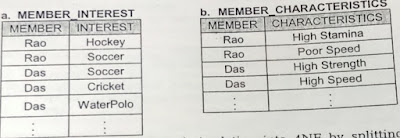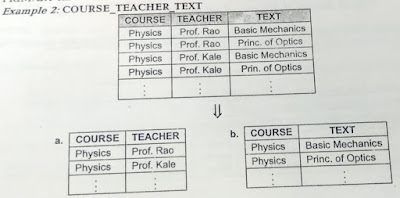Boyce - Codd Normal Form (BCNF):
A relation is in Boyce Codd normal form if every attribute (for every set of attributes) on which some other
attributes is fully functionally dependent is also a candidate key for a primary
key of the relation (i.e. Candidate key).
Consider the
following relation:
The
candidate for primary key are:
·
Member
+ Sport
·
Member
+ Coach
because either of
these uniquely identifies the row.
The attribute Coach
is not a candidate for a primary key even though the attribute Sport is fully functional dependent on
it, since a Coach is associated with only one Sport (assumption a coach is an
expert in one sport, though he can coach other sports also).
Since the relation has an attribute (Coach) on which some
other attribute is fully functionally dependent, but it is not a candidate for
the primary key, the above relation is not fully normalized. The above relation
will result in the following problems:
If Mr Rajesh Iyer withdraws from the membership, information
about coach Rane is also lost.
If coach Kurian’s name is mis-spelt and has to be corrected
to Kurien, the update needs to be done in all the rows.
A better implementation of the situation can be made through
the following relations.
By this
process we have reduced the 3NF to BCNF by ensuring that they are in 3NF for
every candidate key.
Ex 2:
The relations can be further decomposed to 4NF
and 5NF if still there exists multivalued dependencies. However, this decomposition
may lead to increased overhead on the system like maintaining the complex
relationships between the tables, indexing mechanism, etc.
Fourth Normal Form (4NF):
A relation is in the 4NF, if it is in the BCNF and does not have any independently multi-valued
components of the primary key.
Assume that the Club
keeps records of its members. For each member it keeps a list of sports that
the member is most interested in and a list of most striking characteristics of
each member which are inherent in the member and are in no way dependent on the
sport.
Ex 1:
According to the above structure, if another interest for
example Cycling is added for Mr Rao then, 2 more additional
rows will be added - one for High
Stamina and another for Poor Speed. Thus, the above relation is
normalized further to get 2 relations.
Thus, we have reduced BCNF entity relation into 4NF by
splitting into two relations the independently
multivalued component of the primary key.
Ex 2:
Fifth Normal Form (5NF):
It is also called as Project
Join Normal Form (PJNF).
If any relation has
functional, multivalued and join dependencies then it can be decomposed into
5NF. For ex: consider
the Loan relation with the following
attributes.
(loan_no, branch_no, customer_no, amount)
This relation can be defined as a set of all tables on the
loan relation such that:
·
The
loan represented by loan_no is made by
the branch represented by the branch_no.
·
The
loan represented by the loan_no is made to the customer represented by the
customer_no.
·
The
loan represented by loan_no is in the amount represented by amount.
Thus, the definition of the above relation is in the
conjunction of 3 predicates with join dependencies:
·
on
loan_no and branch_no.
·
on
loan_no and customer_no.
·
on loan_no and amount.
To put the Loan relation into PJNF, we must decompose it into
3 relations specified by the join dependency:
·
Loan_Branch
(loan_no, branch_no)
·
Loan_Customer
(loan_no, customer_no)
·
Loan_Amount
(loan_no, amount)






No comments:
Post a Comment